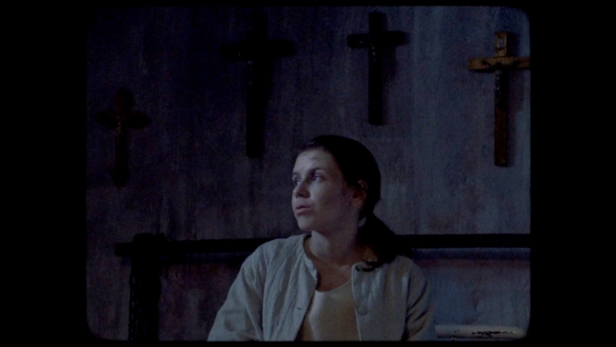Aislinn Clarke’s The Devil’s Doorway takes place during 1960 in Ireland. Father Thomas Riley (Lalor Roddy) and Father John Thornton (Ciaran Flynn) have been sent by the Vatican to investigate anonymous claims of a religious miracle that occurred in the chapel of a women’s refuge cum workhouse run by nuns. Young, faithful John records everything that they witness with a camera, while his elder mentor – nicknamed ‘Doubting Thomas’ for his religious scepticism – sets about debunking the evidence at hand and finding the ‘trickster’ responsible. Despite the insistence of the Mother Superior (Helena Bereen) that no children have lived there for decades, John keeps hearing – and seeing – children playing outside his room at night. Already disturbed by the nuns’ cruel treatment of the women, both Fathers are horrified to discover a young pregnant woman, Kathleen (Lauren Coe), being kept in chains downstairs. John’s suspicion that Kathleen is possessed will eventually lead the two men to deep, dark caverns below, where demonic evils have been committed and secrets have been buried.
Found footage has always been a mode rather than a (sub)genre. It is a means of confining a story to a restrictive, intradiegetic point of view, with the camera(s) part of the action and the medium a part of the message. Although almost any narrative could be made to fit this format, found footage has become particularly – although not exclusively – associated with the horror genre, not least because of the immediacy with which the format can conjure a faux-documentary reality from the most unreal and uncanny of events, and also, of course, because of its suitability to very low budgets and small crews. Still, after Danile Myrick and Eduardo Sánchez’s The Blair Witch Project both repopularised the format and showed its potential for a massive return on investment, found footage has, over the subsequent two decades, become exhausted through excessive use. So while any viewer unfamiliar with the trends in post-millennial horror might be both shaken and stirred to lose their found footage cherry, committed genre fans have seen it all before, and will know almost every trick in the book.
This is ostensibly true of The Devil’s Doorway, which is after all only the latest in a long line of films (The Last Exorcism, The Devil Inside, The Possession Of Michael King, The Taking Of Deborah Logan, The Vatican Tapes) to subject motifs of possession and exorcism to the first-person format, and which, in supposedly unearthing filmed materials from the pre-video, pre-camcorder days of 1960, is following in the footsteps of previous ‘retro found footage’ films like Richard Raphorst’s Second World War monsterfest Frankenstein’s Army or Chris Sparling’s 1976-set The Atticus Institute – the latter also featuring possession as a principal theme. Yet far from using the format itself to lend her feature debut a putative grounding in reality, Clarke instead, from the very outset, anchors her film’s fictive happenings to actual history, and more particularly to the ‘Magdalene Laundries’ – all too real institutions run by the Roman Catholic Church as asylums for ‘fallen women’, and notorious as hotbeds of exploitation and abuse.
Here ‘found footage’ serves as a metaphor for an actual buried truth about one of these institutions that would not come to light until 1993. There will, as the title implies, be devilry at the door, but Clarke’s film is less concerned with demonising its (dis)possessed women than with exposing the Church’s own hypocrisy and vicious practices. This devil is organised, systemic and institutional, and the marginalised, the meek and the innocent are its sacrificial victims and martyred witnesses. So while, with its virgin births, miraculous resurrections, upturned crucifixes and shattered icons, The Devil’s Doorway comes across as an inverted, iconoclastic retelling of the New Testament in mid-twentieth-century Ireland, it will turn out to be as much a story of ghosts and the unrestful dead as a Satanic saga of heaven above and hell below.
The Devil’s Doorway was seen and reviewed at Arrow Video FrightFest 2018.
